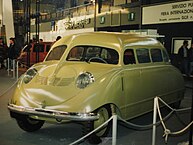Minivan
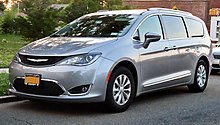
Minivan (sometimes called simply as van) is a North American car classification for vehicles designed to transport passengers in the rear seating row(s), with reconfigurable seats in two or three rows. The equivalent classification in Europe is the M-segment, more commonly known as an MPV (multi purpose vehicle) or a people carrier / mover.[2] Minivans often have a 'one-box' or 'two-box' body configuration, a higher roof, a flat floor, a sliding door for rear passengers, and high H-point seating.
Compared with a full-size van, minivans are now based on a passenger car platform and have a lower body (to fit inside a typical garage door opening). Some early versions, such as the Ford Aerostar and Chevrolet Astro, utilized a compact pickup truck platform.[3][4]
The largest size of minivans is also referred to as 'Large MPV' and became popular following the introduction of the 1984 Dodge Caravan and Renault Espace. Typically, these have platforms derived from D-segment passenger cars or compact pickups. Since the 1990s, the smaller Compact MPV and Mini MPV sizes of minivans have also become popular.[5] If the term 'minivan' is used without specifying a size, it usually refers to the largest size (i.e. Large MPV).
Etymology[]
The term minivan originated in North America in order to differentiate the smaller passenger vehicles from full-size vans (such as the Ford E-Series, Dodge Ram Van, and Chevrolet Van), which were then simply called 'vans'.[6]
The first known use of the term minivan was in 1959,[7] however it was not until the 1980s that the term became commonly used.
Predecessors[]
The 1936 Stout Scarab is often regarded as the first minivan.[8][9][10][11] The passenger seats in the Scarab were moveable and could be configured for the passengers to sit around a table in the rear of the cabin. Passengers entered and exited the Scarab via a centrally-mounted door.
The DKW Schnellaster — manufactured from 1949 to 1962— featured front-wheel drive, a transverse engine, flat floor and multi-configurable seating, all of which would later become characteristics of minivans.[12]
In 1950, the Volkswagen Type 2 adapted a bus-shaped body to the chassis of a small passenger car (the Volkswagen Beetle). When Volkswagen introduced a sliding side door to the Type 2 in 1968, it then had the prominent features that would later come to define a minivan: compact length, three rows of forward-facing seats, station wagon-style top-hinged tailgate/liftgate, sliding side door, passenger car base.[13]
The 1956-1969 Fiat Multipla also had many features in common with modern minivans. The Multipla was based on the chassis of the Fiat 600 and had a rear engine and cab forward layout.[14]
The early 1960s saw Ford and Chevrolet introduce "compact" vans for the North American market, the Econoline Club Wagon and Greenbrier respectively. The Ford version was marketed in the Falcon series, the Chevrolet in the Corvair 95 series. The Econoline grew larger in the 1970s, while the Greenbrier was joined by (and later replaced by) the Chevy Van.
Stout Scarab
(1936-1942)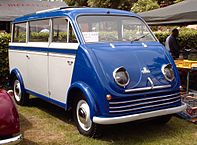
DKW Schnellaster
(1949-1962)
Volkswagen Type 2
(1950-1967)Fiat 600 Multipla
(1956-1969)
North America[]
1970s to 1990s[]
In the late 1970s, Chrysler began a development program to design "a small affordable van that looked and handled more like a car."[15] The result of this program was the first American minivan, the 1984 Plymouth Voyager.[16] The Voyager debuted the minivan design features of front-wheel drive, a flat floor and a sliding door for rear passengers.[17] The badge-engineered Dodge Caravan was also released in time for the 1984 model year, and was sold alongside the Voyager.[18][15]
The term minivan came into use largely in comparison to size to full-size vans; at six feet tall or lower, 1980s minivans were intended to fit inside a typical garage door opening.[19] In 1984, The New York Times described minivans "the hot cars coming out of Detroit,"[20] noting that "analysts say the mini-van has created an entirely new market, one that may well overshadow the... station wagon."[20]
In response to the popularity of the Voyager/Caravan, General Motors released the 1985 Chevrolet Astro and GMC Safari badge-engineered twins, and Ford released the 1986 Ford Aerostar. These vehicles used a traditional rear-wheel drive layout, unlike the Voyager/Caravan.[19][21] By the end of the 1980s, demand for minivans as family vehicles had largely superseded full-size station wagons in the United States.[22]
During the 1990s, the minivan segment underwent several major changes. Many models switched to the front-wheel drive layout used by the Voyager/Caravan minivans. For example, Ford replaced the Aerostar with the front-wheel drive Mercury Villager (a rebadged Nissan Quest) for 1993 and the Ford Windstar for 1995. The models also increased in size, as a result of the extended-wheelbase ("Grand") versions of the Voyager and Caravan which were launched in 1987. An increase in luxury features and interior equipment was seen in the Eddie Bauer version of the 1988 Ford Aerostar, the 1990 Chrysler Town & Country, and the 1990 Oldsmobile Silhouette. The third-generation Plymouth Voyager, Dodge Caravan, and Chrysler Town & Country – released for the 1996 model year – were available with an additional sliding door on the driver's side.

Dodge Caravan
(1984-1990)
Ford Aerostar
(1986-1997)
Chevrolet Astro
(1990-1994)
2000 to present[]
The highest selling year for minivans was in 2000, when 1.4 million units were sold.[23] However, in the following years, the increasing popularity of sport utility vehicles (SUVs) began to erode sales of minivans. North American sales of the Volkswagen Transporter (sold as the 'Volkswagen Eurovan') ceased in 2003. Ford exited the segment in 2006, when the Ford Freestar was canceled, Chrysler discontinued its short-wheelbase minivans in 2007 (although long-wheelbase minivans remained in production in the form of the Chrysler RT-platform minivans) and General Motors exited the segment in 2009 with the cancellation of the Chevrolet Uplander. It has been suggested that the lesser popularity of minivans is due to the minivan's image as a vehicle for older, domestically-oriented drivers.[24]
In 2013, sales of the segment reached approximately 500,000 (one-third of its 2000 peak).[23] Despite the declining sales for the segment in the late 2000s, several European brands launched minivans in the North American market. The Volkswagen Routan (a rebadged Dodge Grand Caravan) was sold from 2009 to 2013. In 2010, Ford began North American sales of the European-built Ford Transit Connect Wagon. North American sales of the Mercedes-Benz Vito (sold as the 'Mercedes-Benz Metris') began in 2016. However, the Nissan Quest and Mazda MPV were both discontinued in 2016.
The five highest selling models in the United States in 2018 were the Dodge Grand Caravan, Chrysler Pacifica, Honda Odyssey, Toyota Sienna, and Kia Sedona.[25]

Dodge Grand Caravan
(2008–2020)
Honda Odyssey
(2018–present)
Chrysler Voyager
(2019–present)
Toyota Sienna
(2020–present)
Europe[]
Introduced several months after the Chrysler minivans, the 1984 Renault Espace was the first European-developed minivan developed primarily for passenger use (as the Volkswagen Caravelle/Vanagon was a derivative of a commercial van). Beginning development in the 1970s under the European subsidiaries of Chrysler,[26] the Espace was intended as a successor for the Matra Rancho (a crossover vehicle before the fact), leading to its use of front-hinged doors. While slow-selling at the time of its release, the Espace would go on to become the most successful European-brand minivans.[27]
Initially intending to sell the Espace in the United States, the 1987 sale of AMC to Chrysler canceled plans of Renault doing so. At the end of the 1980s, Chrysler and Ford commenced sales of American-brand minivans in Europe, selling the Chrysler Voyager and Ford Aerostar (with varying degrees of success). Deriving its minivans from American designs, General Motors imported the Oldsmobile Silhouette (branded as the Pontiac Trans Sport), later marketing the American-produced Opel/Vauxhall Sintra.
In the 1990s, several joint ventures produced long-running minivan designs. In 1994, the Sevel Nord-produced Eurovans were introduced, marketed by Citroën, Fiat, Lancia, and Peugeot; two generations were produced through 2014. In contrast to the Espace, the Eurovans were produced with two sliding doors; to increase interior space, the gearshift was relocated to the dashboard and the handbrake was moved. In 1995, Ford of Europe and Volkswagen entered a joint venture, producing the Ford Galaxy, SEAT Alhambra, and Volkswagen Sharan. Adopting a similar configuration as the Espace, the three model lines were launched with front-hinged doors; for 2010, SEAT and Volkswagen introduced a second-generation, adopting sliding doors. Despite high expectations during the 1990s, the full-size MPV market fell short, and some consumers thought of MPVs as being large like vans. Other MPVs on the market at the time include Mitsubishi Space Wagon and Honda Shuttle. Renault set a new "compact MPV" standard with the Renault Scénic in 1996 which became popular.[28]
Volkswagen Sharan (1995–2020)

Ford Galaxy (1995–2022)
Citroën Evasion (1994-2002)

Mercedes-Benz V-Class (1996–present)
The five highest selling minivans in Europe in 2018 were the Ford S-Max, SEAT Alhambra, Volkswagen Sharan, Renault Espace, and Ford Galaxy.[29]
Asia[]
Japan[]
In 1982, the Nissan Prairie became one of the first compact minivans. Derived closely from a compact sedan, the Prairie was configured with sliding doors, folding rear seats, and a lifting rear hatch. The Mitsubishi Chariot (exported to North America as the Dodge/Plymouth Colt Vista) adopted nearly the same form factor, instead using wagon-style front-hinged doors.
To match the launch of minivans by American manufacturers, the Toyota TownAce, Nissan Vanette, and Mitsubishi Delica were introduced to North America in 1984, 1986, and 1987, respectively. While all three vehicles were assembled by different manufacturers, in the United States, each model line was named "Van" and "Wagon" (for cargo and passenger vans, respectively). Using a one-box design similar to the Volkswagen Vanagon, the mid-engine vans were slotted in size between kei cars and commercial vehicles, sharing components with compact trucks.
For 1989, the Mazda MPV was the first Japanese-brand minivan developed from the ground up specifically for North American sale; as it exceeded compact size regulations, the MPV was heavily taxed in Japan and marketed as a luxury vehicle. Derived from the Mazda 929 sedan, the larger chassis of the MPV allowed for the fitment of an optional V6 engine and four-wheel drive. In contrast to the sliding doors of American minivans, a hinged passenger-side door was used (a driver-side door was added for 1996, as Mazda gradually remarketed the model line as an early crossover SUV).
For 1990, Toyota introduced the Toyota Previa to replace the Van/Wagon in North America. While the Previa largely continued the mid-engine configuration of its TownAce predecessor (which continued in Japan),[30] the model line was designed solely as a passenger vehicle sized to compete with American-market minivans; in Japan, the Previa was named the Toyota Estima. Along with its highly rounded exterior, the Previa was distinguished with nearly panoramic window glass (excluding the B- and D-pillars). For 1998, the Toyota Sienna became the first Japanese-brand minivan assembled in North America, replacing the Previa in that market. Outside of North America, the Previa was redesigned in 2000, adopting a front-wheel drive layout; it remains in production for sale (primarily in Japan and Australia). Slotted between the Previa and Sienna in size, Toyota introduced the Toyota Alphard in 2002. Developed as a luxury-oriented model, the Alphard is marketed primarily in Asia; the Alphard forms the basis of the Lexus LM, the first Lexus-brand minivan.
Following the 1990 discontinuation of the Nissan Vanette into the United States, Nissan also ended the sale of the second-generation Prairie (badged as the Axxess). To reenter the segment with a vehicle developed specifically for North America, Nissan had entered into a joint venture with Ford to develop and assemble a minivan. For 1993, the agreement led to the launch of the front-wheel drive Nissan Quest (and its Mercury Villager counterpart). Similar in size to the GM APV minivans (though far more conventional in exterior design), the Quest was assembled by Ford, but the chassis and powertrain were derived from the Nissan Maxima. Following the end of the Ford joint venture, Nissan developed its own version of the Quest for 2004, which was produced through 2017. In markets outside of North America, Nissan introduced the Nissan Serena in 1990 and the Nissan Elgrand in 1997; the luxury-oriented Elgrand is a narrower-body version of the 2010-2017 Quest.
For 1995, Honda entered the minivan segment, introducing the Honda Odyssey for both Japan and North America. Derived from the Honda Accord, the Odyssey was designed with front-hinged doors. In a design feature that would become widely adopted by other manufacturers, the Odyssey introduced a rear seat that folded flat into the floor (replacing a removable rear seat). For 1999, Honda introduced separate versions of the Odyssey for North America and the rest of the world, with North America receiving a larger vehicle with sliding doors (adopting the configuration of the Chrysler minivans); other markets received a redesign of the previous generation (including the wagon-style doors). Since 1996, Honda has produced the Honda Stepwgn mid-size MPV, designed with a higher cabin (in contrast to the international-market Odyssey).
Expanding beyond compact MPVs, Mitsubishi entered the minivan segment in 2003 with the Mitsubishi Grandis, using front-hinged doors. Sold outside of North America, the Grandis was marketed through 2011.

Nissan Elgrand (1997–Present)

Toyota Alphard (2002–present)

Honda Elysion (2004–present)
South Korea[]
Adapting a similar layout to the Chrysler minivans, the Kia Carnival (also sold the Kia Sedona) was introduced in 1998 with dual sliding doors. Sharing its configuration with the Honda Odyssey, the Hyundai Trajet was sold from 1999 to 2008 in markets outside of North America; the Hyundai Entourage was a rebadged Kia Sedona.
Introduced in 2004, the SsangYong Rodius is the highest-capacity minivan, seating up to 11 passengers.
China[]
In 1999, Shanghai GM commenced production of the Buick GL8 minivan, derived from a minivan platform designed by GM in the United States. After two generations of production, the GL8 is the final minivan produced by General Motors or its joint ventures today.

Buick GL8 (1999–present)
Taiwan[]
In 2010, Luxgen launches the world's first electric MPV, Luxgen EV+, a 7-passenger.[31]

Luxgen M7 EV+ (2010-present)
Characteristics[]
Chassis[]
In contrast to larger vans, minivans/MPVs use a front-engine, front-wheel drive layout nearly exclusively; some model lines offer all-wheel drive as an option. Alongside the adoption the form factor of the Chrysler minivans, the configuration allows for less engine intrusion and a lower floor in the passenger compartment. In line with larger full-size vans, unibody construction has been used nearly exclusively (the spaceframe design of the Renault Espace and the GM APV minivans being a notable exception).
Minivans/MPVs are produced on either distinct chassis architecture or share platforms with larger sedans; more recent designs also share common platforms with SUVs/CUVs. To reduce engineering and production costs, minivans have shared chassis and powertrain components with other vehicle lines.
Body style[]
Using a front-engine layout nearly exclusively, minivans/MPVs use either a two-box or a one-box body design. The latter is commonly used in more recent designs, as pedestrian safety requires use of higher hoodlines. The passenger compartment is fitted with two front bucket seats followed by one or two rows of seats, typically in a 2+2+3 configuration.
In line with their larger counterparts, minivans/MPVs use multiple configurations of side and rear doors. Many examples use sliding doors while others offer forward-hinged doors (in line with passenger cars). Initially a feature introduced on the 1982 Nissan Prairie, the 1996 Chrysler minivans introduced a driver-side sliding door; by 2002, all minivans were sold with doors on both sides of the body. Most minivans are configured with a rear liftgate; few minivans have used panel-style rear doors (cargo versions of the Chevrolet Astro, Ford Aerostar, and the Mercedes-Benz Metris).
As a multi-purpose vehicle (though not a commercial vehicle), minivans are designed with a reconfigurable interior to carry either passengers or cargo. The first examples were designed with removable rear seats unlatched from the floor for removal and storage (in line with larger vans); however, users gave poor reception to the design (as many seats were heavy and hard to remove). For 1995, the Honda Odyssey introduced a third-row seat that folded flat into the floor; a design similar to a car, the fold-flat rear seat configuration of the Odyssey was adopted by many competitors, with Chrysler introducing fold-flat second-row seats for 2005.
Related vehicle categories[]
Mini MPV[]

Mini MPV – an abbreviation for Mini Multi-Purpose Vehicle – is a vehicle size class for the smallest size of minivans (MPVs). The Mini MPV size class sits below the compact MPV size class and the vehicles are often built on the platforms of B-segment hatchback models.
Several PSA Peugeot Citroën minivans based on B-segment platforms have been marketed as 'leisure activity vehicles' in Europe.[32] These include the Citroën Berlingo (1996–present).
Examples: Category:Mini MPVs ( 69 )
Compact MPV[]
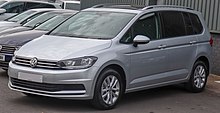
Compact MPV – an abbreviation for Compact Multi-Purpose Vehicle – is a vehicle size class for the middle size of MPVs/minivans. The Compact MPV size class sits between the mini MPV and minivan size classes.
Compact MPVs remain predominantly a European phenomenon, although they are also built and sold in many Latin American and Asian markets. As of 2016, the only compact MPV sold widely in the United States is the Ford C-Max.
Examples: Category:Compact MPVs ( 109 )
Leisure activity vehicle[]
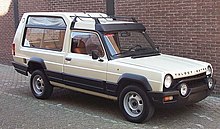
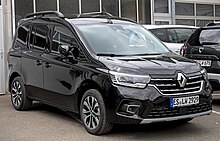
A leisure activity vehicle (abbreviated LAV) is a small van or minivan; the segment is popularized primarily in Europe.[32] One of the first LAVs was the 1977 Matra Rancho (among the first crossover SUVs and a precursor to the Renault Espace), with European manufacturers expanding the segment in the late 1990s, following the introduction of the Citroën Berlingo and Renault Kangoo.
Leisure activity vehicles are typically derived from supermini or subcompact car platforms, differing from mini MPVs in body design. To maximize interior space, LAVs are taller in height with a vertically-oriented liftgate (or the side-hinged doors of a cargo van); the body typically features a more vertically-oriented windshield and longer hood/bonnet. Marketed as an alternative to sedan-derived small family cars, LAVs have seating with a lower H-point than MPVs or minivans, offering two (or three) rows of seating.
Though sharing underpinnings with superminis, subcompacts, and mini MPVs, the use of an extended wheelbase can make leisure activity vehicles longer than the vehicles they are derived from. For example, the Fiat Doblò is one of the longest LAVs with a total length of 4,255 mm (167.5 in), versus the 4,050 mm (159.4 in) of the Opel Meriva (a mini MPV) and the 4,030 mm (158.7 in) of the Peugeot 206 SW (a supermini).
Examples: Category:Leisure activity vehicles ( 24 )
References[]
- ^ "Ranked: 5 best-selling new minivans in the U.S. in 2020". AutomotiveMap. 10 August 2020. Retrieved 17 January 2021.
No. 1 - Chrysler Pacifica (93,802 sold)
- ^ "minivan". Cambridge Advanced Learner’s Dictionary & Thesaurus. Cambridge University Press. Retrieved 30 May 2017.
- ^ Taylor, Rich (February 1990). "The Light Vantastics". Popular Mechanics. 167 (2): 64. Retrieved 17 September 2020.
- ^ "Mass Transit". Popular Mechanics. 164 (11): 72. November 1987. Retrieved 17 September 2020.
- ^ "Our pick: Top 10 used mini-MPVs". Auto Trader. 3 August 2010. Archived from the original on 5 March 2012. Retrieved 28 February 2012.
- ^ Sorokanich, Robert (2 November 2013). "30 Years Ago Today, Chrysler Invented the Minivan, And Changed History". Gizmodo. Retrieved 2 May 2016.
- ^ "Definition of Minivan". merriam-webster.com. Retrieved 30 March 2019.
- ^ Patton, Phil (6 January 2008). "A Visionary's Minivan Arrived Decades Too Soon". The New York Times. Retrieved 6 September 2014.
- ^ "Cars of Futures Past – Stout Scarab". hemmings.com. Retrieved 30 March 2019.
- ^ "Revisiting Classics: The Stout Scarab". drivezing.com. 23 August 2018. Retrieved 30 March 2019.
- ^ "The Stout Scarab is the World's First Minivan, and the First Car with a Mustache". tflcar.com. 19 May 2018. Retrieved 30 March 2019.
- ^ Niedermeyer, Paul (29 March 2010). "The Mother Of All Modern Minivans: 1949 DKW Schnellaster". The Truth About Cars. Retrieved 2 December 2020.
- ^ Kindy, David (6 March 2020). "How the Volkswagen Bus Became a Symbol of Counterculture". Smithsonian Magazine. Retrieved 2 December 2020.
- ^ Mattews, Nigel (26 November 2014). "Fiat invented minivan concept with the Multipla". Driving Canada. Retrieved 2 December 2020.
- ^ a b "America on the Move - Dodge Caravan". Smithsonian Institution - National Museum of American History. Retrieved 2 May 2016.
- ^ "Creating the Plymouth, Dodge, and Chrysler Minivan: The Caravan/Voyager Development Story". allpar.com. Retrieved 31 March 2019.
- ^ "The Ford Mustang and the minivan have an amazing shared history". Business Insider. Retrieved 31 March 2019.
- ^ "Coolest Minivans of All Time". autoblog.com. Retrieved 31 March 2019.
- ^ a b Stepler, Richard (February 1985). "New generation minivans". Popular Science. 226 (2): 74–75. Retrieved 2 May 2016.
- ^ a b Kurczewski, Nick (15 December 2016). "Driving Down Memory Lane in the Original Minivan". The New York Times. Retrieved 2 May 2017.
- ^ Lamm, Michael (April 1985). "PM drives GM's new minivan". Popular Mechanics. 162 (4): 48, 168. Retrieved 23 October 2018.
- ^ "Best of the Minivans". Kiplinger's Personal Finance. 44 (7): 41. July 1990. Retrieved 26 December 2015.
- ^ a b Eisenstein, Paul A. (10 May 2014). "'Mom mobiles' a shrinking category for automakers". CNBC. Retrieved 26 December 2015.
- ^ Neil, Dan (17 October 2007). "Head of the Family". Los Angeles Times. Archived from the original on 29 July 2018.
- ^ "US car sales analysis 2018 – Minivan segment". carsalesbase.com. 24 January 2019. Retrieved 2 April 2019.
- ^ Lewin, Tony (2003). How to Design Cars Like a Pro: A Complete Guide to Car Design from the Top Professionals. Motorbooks International. ISBN 0-7603-1641-4.
- ^ "Renault Espace, this is your life". topgear.com. 23 April 2015. Retrieved 3 April 2019.
- ^ "The reasons why full-size minivans don't sell in Europe". just-auto.com. 30 May 2000. Retrieved 17 September 2020.
- ^ "European sales 2018 large MPV segment". carsalesbase.com. 15 February 2019. Retrieved 3 April 2019.
- ^ Schefler, Jim (September 1983). "Toyota's mini-van". Popular Science. 223 (3): 123. Retrieved 23 October 2018.
- ^ "Taiwan's Luxgen-Launches-Worlds-First-Electric-Mpv". GreenCarReports. 9 July 2010. Retrieved 9 July 2010.
- ^ a b Patrascu, Daniel (13 February 2018). "PSA Previews New Generation Leisure Activity Vehicles (LAV)". autoevolution. Retrieved 21 October 2018.
Further media[]
| Wikimedia Commons has media related to Minivans. |
- Videos
- "The Fall of the Minivan". CNBC. 18 September 2019. Archived from the original on 11 December 2021. Retrieved 24 November 2020 – via YouTube.
- Minivans
- Compact MPVs
- Mini MPVs
